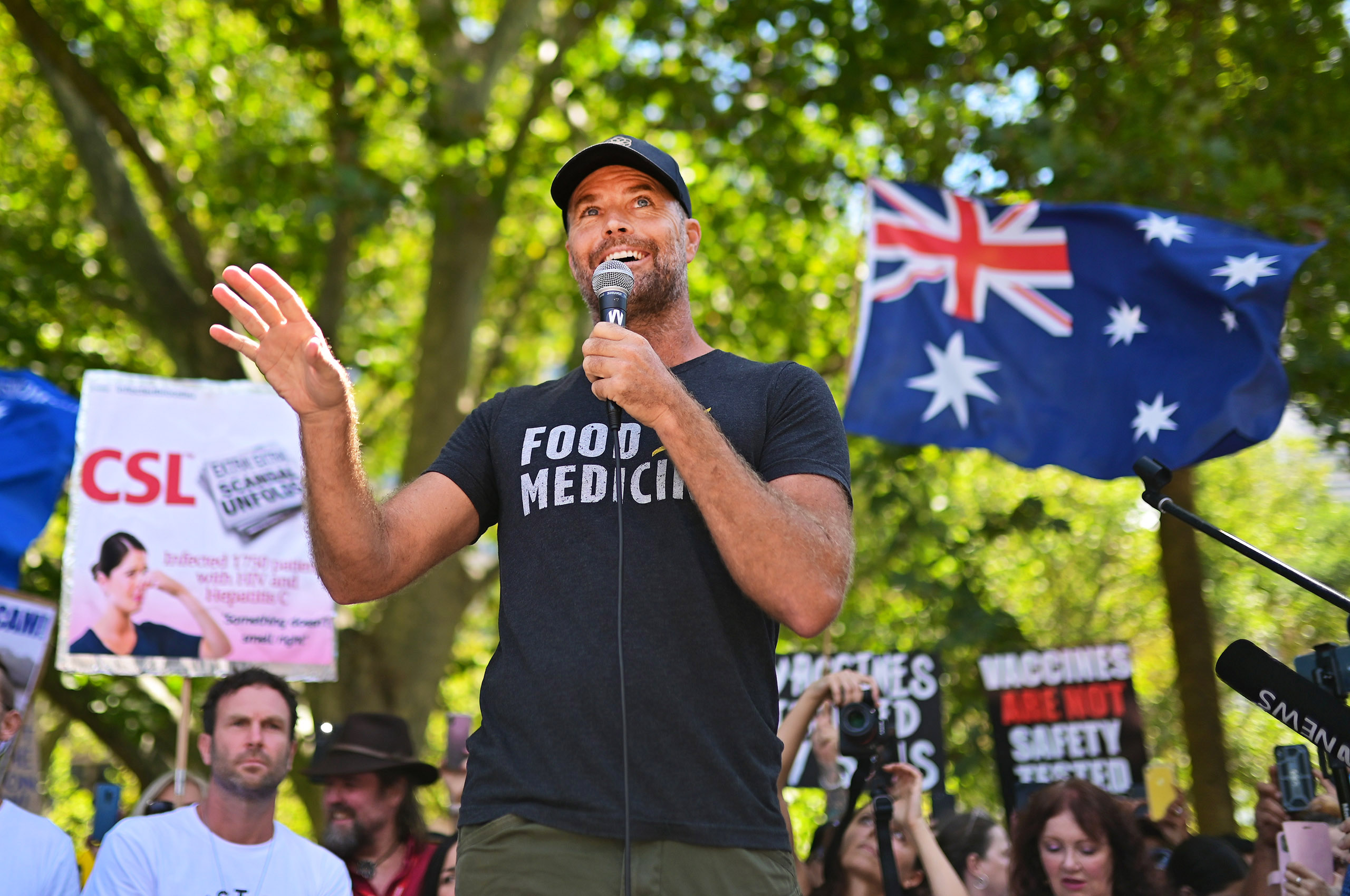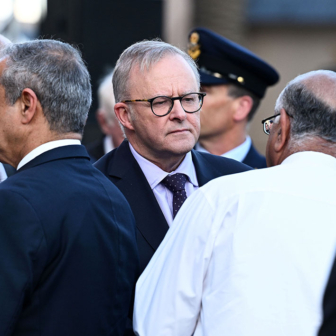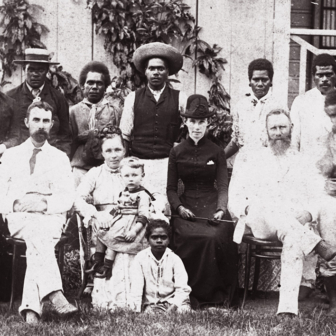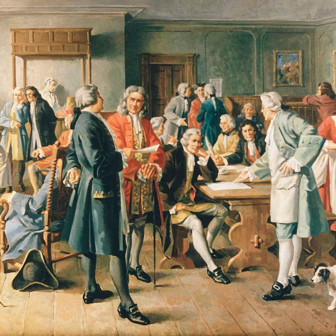Everyone can enjoy conspiracy theories. They offer a kind of speculative play, a winking challenge to authority. But what happens when the narrative takes control and becomes an all-consuming call to action? Ariel Bogle and Cam Wilson’s new book, Conspiracy Nation, is as much an investigation of individuals unyieldingly dedicated to stories as it is about how stories can take control and not let go. The appeal of conspiracies, for those who are pulled into them, is that “they place you in the centre of an epic tale.”
Drawing on years of reporting, on-the-ground interviews and undercover spa retreats, Conspiracy Nation opens with the Covid-era protests that drew fringe actors to centre stage: one where mothers marched with placards scrawled in pseudolaw jargon, Pete Evans’s “activated almonds” promised better living without fluoridation or wi-fi, and Facebook comments wove mythologies from fragments of real histories and real abuse.
But Bogle and Wilson are not simply documenting an ideological carnival bedecked with tinfoil-hatted misfits as though they are the aberrational individuals. They are asking what these conspiratorial narratives about vaccines, stolen sovereignty, paedophile rings and false-flag events tell us about contemporary life in Australia.
They take the reader from QAnon-driven family tragedies to pseudolegal micronations, from the anti-vaxx off-grid spiritualism of Byron Bay to the cynical weaponisation of #SaveTheChildren hashtags. While conspiracies affect individuals, and while individuals trade in them to amass followers and networks of support, Bogle and Wilson argue that they are symptoms and expressions of deeper structural issues and anxieties. Grief, loneliness, settler guilt, economic insecurity, trauma, alienation and a search for belonging pulse beneath them.
One of the most affecting chapters, “QAnon and Two Families,” shows how these narratives can destroy lives. The first family, a couple, breaks apart after years of loving devotion because one begins to believe in QAnon. It is a personal tale of losing a shared reality and what that means for the non-believer. The second family, the Dare family, were the victims of the Wieambilla shootings in Queensland’s Western Downs in 2022.
In that notorious incident, conspiracy-fuelled brothers Gareth and Nathanial Train shot and killed two police officers and their neighbour, Alan Dare. The Trains were then shot dead after an armed standoff with police. The two brothers were obsessed with conspiracies — about the Port Arthur massacre, Covid-19 and the pseudolaws associated with “sovereign citizenship” — but Bogle and Wilson also focus on the shootings’ impact on Kerry Dare, whose husband Alan was killed when he went to investigate the sound of gunshots. For her, the tragedy was compounded by the media and police, who rewrote her husband’s death into a cinematic tale of bravery and martyrdom in the face of villainy, reducing her grief to someone else’s fable.
Examining the Port Arthur massacre, Bogle and Wilson explore the internet’s role in reframing Australia’s most traumatic massacre as a “false flag” event staged by shadowy state actors. They detail how Port Arthur conspiracist Joe Vialls went from publishing in obscure magazines to wider notoriety as an online theorist. As his theory spread, Vialls’s role changed, too, and he was increasingly absorbed by the very narrative he helped create. The conspiracy he had helped popularise turned against him after other online theorists came to suspect that he was a plant, someone on the inside pulling the strings.
Eventually, as Bogle and Wilson observe, everyone becomes part of the plot. Conspiracies reward adherents with a starring role in an epic — you, too, can fight against the darkness! — but the danger, as their book repeatedly illustrates, is that the story keeps going. Control is illusory: even the authors of these shadowy mythologies aren’t safe from the stories they unleash. The role of the hero is, of course, tarnished. Some people, however, are safer than others.
Because it is a diagnosis of the political body, one of Conspiracy Nation’s strengths is its intersectional reading of conspiracy cultures. Bogle and Wilson show how white identity — unsteady, reframed and sometimes radicalised — sits at the centre of many conspiracy theories in Australia.
Their eighth chapter, “I Do Not Consent” investigates those individuals, often called sovereign citizens, who believe not only that the state has been taken over by corrupt corporations but also that a legal basis exists for they themselves to withdraw their recognition of the state’s authority. Bogle and Wilson claim that pseudolaw “feels like the most Australian of all the conspiracy theories we looked at in this book.” Not only is “our system of justice and its fraying ties to the United Kingdom’s centuries of legal history reflected back at you” but “pseudolaw is obsessed with the idea that an outside body has taken over an existing culture. In Australia, that’s our history.”
This insight sets up their standout chapter on pseudolaw and First Nations communities. After pseudolaw originated among white fantasists in the United States, it travelled to Australia in the 2010s. Here, it found traction in communities with reasons to mistrust the state, including First Nations, by attaching to real histories and real traumas. The authors tread carefully here, noting that while pseudolaw borrows the language of Indigenous sovereignty, it strips it of relational obligations, replacing kinship and land with pure self-interest and the right to opt out of collective life with no accountability.
The problems are compounded when non-Aboriginal people co-opt Indigeneity to be closer to nature or give their conspiracies the veneer of “ancient’’ legitimacy. Not only can this distort the complexities of state law and authority but it can also put First Nations at risk. Interviewees note that, unlike sovereign citizenship, which is “at its core white privilege” that rarely works for white people, “First Nations people do not have the protection of whiteness in their interactions with police when using pseudolaw rhetoric.”
Elsewhere, Bogle and Wilson investigate the “great replacement” theory, the white supremacist fear of being replaced by minorities that inspired the Christchurch terrorist attacks. They also interrogate the more mundane but seductive fusion of alternative wellness and paranoia.
Of the latter, Pete Evans, the former paleo-chef turned wellness influencer turned conspiracy evangelist, is the archetype. To investigate how a personal brand can slide from shilling activated almonds to sharing neo-Nazi symbolism, Wilson goes undercover at Evans’s private spa-like retreat. What he finds isn’t a room of wild-eyed radicals; instead, it’s excellent food and attendees who are lonely and hurt in some way. They are also self-selected: they have already bought into Evans’s narrative of healing, truth, self-actualisation and maybe the harms of 5G, wi-fi and fluoride. They don’t just consume Evans’s story; they live inside it and seek out support and community. Evans himself seems caught in its feedback loop: it isn’t clear if he’s still in control of the narrative or simply playing a role assigned to him by the audience he helped cultivate.
For the authors, the wellness industry is not politically neutral. In an era where sunscreen and sustainability are framed as state poison, the retreat into “natural living” becomes a gesture of distrust, a DIY conspiracy of the self. But focusing on the role of the individual can miss the broader, systemic dimension. Despite a public backlash, people like Evans can still benefit from these conspiracies. Of course, Evans lost some corporate sponsors as his views became more conspiratorial, but some members of his audience and some corporate backers find him even more compelling because of his outrageous claims. Now that conspiracy theories have arisen in mainstream politics in the United States, Bogle and Wilson suggest Evans is in the process of leaping back into the public narrative.
The emotional arc of Conspiracy Nation is not one of scorn but of deep reflection. The authors understand that conspiracies are often powered by what these narratives provide. In times of crisis and chaos, conspiratorial incoherence offers a level of coherence. The theories provide explanations of how power is stacked against individuals. And, yes, they make their adherents into the heroes of an epic tale. They make lonely suffering intelligible, maybe even noble. To believe in the Great Replacement or in #SavetheChildren is to have accessed secret knowledge. To fight against these forces is to be empowered as a (or maybe the) protagonist in a fight against evil.
The most outrageous tales can start as jokes: prime minister Harold Holt was kidnapped by a Chinese submarine; 5G towers triggered the Covid pandemic; the 15-minute city and digital money are efforts to institute new levels of control. But belief is slippery. While we believe, as heroes of our own stories, that we control the narrative, in many ways, it comes to control us. If so, then it ends up concealing more than it reveals. As Bogle and Wilson indicate, what we say about who we are matters. It can change how we see ourselves, who we fight against and how.
One of the book’s provocations is its refusal to let structural inequality off the hook. Conspiracies distort the truth, but they have traction because they latch onto a kernel of reality where harm exists. The state and legal systems are unfair and inequitable. People are abused and mistreated. Elites enrich themselves. History has been manipulated. How we think of ourselves, the stories we tell ourselves, and the diagnoses we make will then shape our actions.
In their final chapters, the authors turn to resistance. Robert Sudy, a former pseudolaw adherent introduced earlier in the book, discusses his attempt to identify and defuse all pseudolaw in Australia. Psychologist Damien Stewart talks about a former client, a veteran, who faced difficulties in having the Department of Veterans’ Affairs recognise his injuries and started sliding into conspiracies. When the department’s position changed and he received financial assistance, his language and views also changed. Anti-trans and anti-LGBTQIA+ activity has inspired Dykes on Bikes to fight against conspiracies by supporting drag queens reading at libraries.
The authors are honest: when reality is no longer shared and narratives have captured people, the problem can’t simply be solved by facts. Debunking pseudolaw rarely changes minds. There is no “deprogramming” from conspiracies. What can shift beliefs are reasons to trust authoritative institutions. To the degree that these modest counter-narratives provide an antidote, it is because they provide better, more real stories. Instead of the lone individual discovering the truth and fighting the malicious shadowy forces, counter conspiracies are grounded in community, care and the collective messiness of real life.
Conspiracy Nation is not a hopeful book, but it is an essential read. It documents novel forms of conspiracy theory in Australia, including the rise of anti-vaxx activism and how it relates to anti-fluoridation beliefs, and so much more. It is a thoroughly researched and compelling assessment of conspiracies in Australia. More importantly, it asks that Australia reckon with the material conditions that make the fantastical stories some of its citizens feel plausible.
“We could never rid ourselves of [conspiracies] entirely,” the authors acknowledge, but “we shouldn’t be resigned to accept them when these tropes are wielded dangerously by powerful people.” Australia, they argue, has not reckoned with the impact of the Christchurch attacks or the spread of conspiracy talk into mainstream politics. The gatekeepers of traditional media narratives are gone. Maybe they never existed; maybe they were part of the problem. The technological platforms are built to commodify virality, not veracity. This is the story we have, but not the one we want to tell.
In this sense, the book is less a diagnosis of aberrant individuals than a reflection of who we are and who we want to be. The authors are professional journalists and, therefore, experts in avoiding explicit normative spin, but it also seems as if they want to subtly challenge their audience. If readers can abandon voyeurism, the quick appeal of gawking at “SovCits” on YouTube or TikTok for laughs, then maybe they can engage in the difficult work of repairing trust, community and reality itself.
Even when conspiracies pull at us, we can choose effort, empathy and imagination. It would entail leaving behind the thrill of certainty, heroism and the vilification of the Other and embracing the discomfort of complexity. While there is room to remain hopeful and optimistic, we are left without conclusive answers. The question is whether we’re involved in writing these narratives or whether they’ve already begun to write us. •
Conspiracy Nation: Exposing the Dangerous World of Australian Conspiracy Theories
By Ariel Bogle and Cam Wilson | Ultimo Press | $36.99 | 320 pages




